Perhaps no other animal symbolizes the West as dramatically as the American bison. In prehistoric times millions of these animals roamed the North American Continent from the Great Slave Lake in northern Canada, south into Mexico and from coast to coast. No one knows how many bison there were, but the naturalist, Ernest Thompson Seton, estimated their numbers at sixty million when Columbus landed. They were part of the largest community of wild animals that the world has ever known.
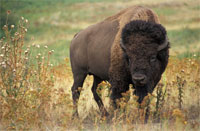 Made In America: The American bison (Bison bison), is a bovine mammal that is the largest terrestrial mammal in North America, and one of the largest wild cattles in the world. With their huge bulk, wood bison, which are the largest subspecies in North America, are only surpassed in size by the massive Asian gaur and wild water buffalo, both of which are found mainly in India. Made In America: The American bison (Bison bison), is a bovine mammal that is the largest terrestrial mammal in North America, and one of the largest wild cattles in the world. With their huge bulk, wood bison, which are the largest subspecies in North America, are only surpassed in size by the massive Asian gaur and wild water buffalo, both of which are found mainly in India.
Massive Herds: The bison inhabited the Great Plains of the United States and Canada in massive herds, ranging from the Great Slave Lake in Canada's far north to Mexico in the south, and from eastern Oregon almost to the Atlantic Ocean, taking its subspecies into account. Its two subspecies are the Plains Bison (Bison bison bison), distinguished by its smaller size and more rounded hump, and the Wood Bison (Bison bison athabascae), distinguished by its larger size and taller square hump.
Also Known As: The Bison is also commonly known as the American buffalo, although it is only distantly related to either the Water buffalo or African buffalo.

Appearance: Bison have a shaggy, dark brown winter coat, and a lighter weight, lighter brown summer coat. Bison can reach up to 2 meters (6 1/2 ft) tall, 3 meters (10 ft) long and weigh 450 to 900 kilograms (900 to 2,000 lbs). The biggest specimens can weigh over 1,000 kilograms (2,200 lb).
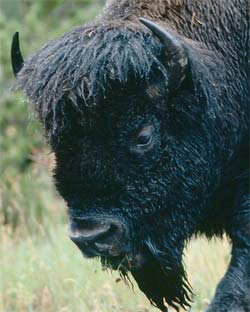 Big-headed: Their heads and forequarters are massive, and both sexes have short, curved horns, which they use in fighting for status within the herd and for defense. Bison mate in August and September; a single reddish-brown calf is born the following spring, and it nurses for a year. Bison are mature at three years of age, and have a life expectancy of 18 to 22 years in the wild and 35 to 40 years in captivity. Big-headed: Their heads and forequarters are massive, and both sexes have short, curved horns, which they use in fighting for status within the herd and for defense. Bison mate in August and September; a single reddish-brown calf is born the following spring, and it nurses for a year. Bison are mature at three years of age, and have a life expectancy of 18 to 22 years in the wild and 35 to 40 years in captivity.
White Buffalo: One very rare condition results in the white buffalo, where the calf turns entirely white. It is not to be confused with albino, since white buffalo still possess pigment in the skin, hair, and eyes. White buffalo are considered sacred by many Native Americans.
Predators: Due to its size and the protection afforded by living in a herd, the bison has few enemies besides humans. Grizzly bears and packs of wolves may attempt to attack a young calf or subadult but only in the dead of winter, when the herd cannot expend the energy to protect stragglers, and a wolf pack take down an adult bison. The only threat, other than hunting by human, that leads to the depletion of wild bisons are interbreeding with domestic bovines. In fact, only a small number of bison herds found in North America today are pure breed bisons.
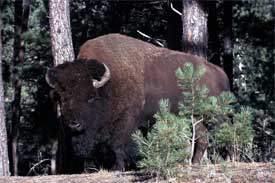 Where They Came From: The American Bison is a relative newcomer to North America, having originated in Eurasia and migrated over the Bering Strait. About 10,000 years ago it replaced the Long-horned Bison (Bison priscus), a previous immigrant that was much larger. It is thought that the Long-horned Bison may have gone extinct because of a changing ecosystem and hunting pressure following the development of the Clovis point and related technology, and improved hunting skills. During this same period, other megafauna vanished and were replaced to some degree by immigrant Eurasian animals that were better adapted to predatory humans. The American bison, technically a dwarf form, was one of these animals. Another was the brown bear, which replaced the short-faced bear. Where They Came From: The American Bison is a relative newcomer to North America, having originated in Eurasia and migrated over the Bering Strait. About 10,000 years ago it replaced the Long-horned Bison (Bison priscus), a previous immigrant that was much larger. It is thought that the Long-horned Bison may have gone extinct because of a changing ecosystem and hunting pressure following the development of the Clovis point and related technology, and improved hunting skills. During this same period, other megafauna vanished and were replaced to some degree by immigrant Eurasian animals that were better adapted to predatory humans. The American bison, technically a dwarf form, was one of these animals. Another was the brown bear, which replaced the short-faced bear.
A Keystone Species: Bison were a keystone species, whose grazing pressure was a force that shaped the ecology of the Great Plains as strongly as periodic prairie fires and which were central to the lifestyle of Native Americans of the Great Plains.
Controversy: But there is now some controversy over their interaction. "Hernando De Soto's expedition staggered through the Southeast for four years in the early sixteenth century and saw hordes of people but apparently did not see a single bison," Charles C. Mann writes in 1491: New Revelations of the Americas Before Columbus.
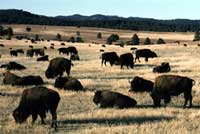 Who Made The Grasslands? Mann discusses the evidence that Native Americans not only created (by selective use of fire) the large grasslands that provided the bison's ideal habitat but also kept the bison population regulated. In this theory, it was only when the Indian population was decimated by wave after wave of epidemic (from diseases of Europeans) after the 16th century that the bison herds propagated wildly. Who Made The Grasslands? Mann discusses the evidence that Native Americans not only created (by selective use of fire) the large grasslands that provided the bison's ideal habitat but also kept the bison population regulated. In this theory, it was only when the Indian population was decimated by wave after wave of epidemic (from diseases of Europeans) after the 16th century that the bison herds propagated wildly.
One Theory: In such a view, the seas of bison herds that stretched to the horizon were a symptom of an ecology out of balance, only rendered possible by decades of heavier-than-average rainfall. Bison were the most numerous single species of large wild mammal on Earth.
Stampeded Over Cliffs: What is not disputed is that before the introduction of horses, bison were herded into large chutes made of rocks and willow branches and then stampeded over cliffs. These bison jumps are found in several places in the U.S. and Canada, such as Head-Smashed-In Buffalo Jump. Large groups of people would herd the bison for several miles, forcing them into a stampede that would ultimately drive many animals over a cliff. The large quantities of meat obtained in this way provided the hunters with surplus which they could trade with other cultures. A similar method of hunting was to drive the bison into natural corrals, such as Ruby site.
 Butchering the Kill: To get full use out of the bison, the Native Americans had a specific method of butchery, first identified at the Olsen-Chubbock archeological site in Colorado. The method involves skinning down the back in order to get at the tender meat just beneath the surface, the area known as the "hatched area." Butchering the Kill: To get full use out of the bison, the Native Americans had a specific method of butchery, first identified at the Olsen-Chubbock archeological site in Colorado. The method involves skinning down the back in order to get at the tender meat just beneath the surface, the area known as the "hatched area."
After the removal of the hatched area, the front legs are cut off as well as the shoulder blades. Doing so exposes the hump meat (in the Wood Bison), as well as the meat of the ribs and the Bison's inner organs.
After everything was exposed, the spine was then severed and the pelvis and hind legs removed. Finally, the neck and head were removed as one. This allowed for the tough meat to be dried and made into pemmican.
Bison Provide All: Later when Plains Indians obtained horses, it was found that a good horseman could easily lance or shoot enough bison to keep his tribe and family fed, as long as a herd was nearby. The bison provided meat, leather, sinew for bows, grease, dried dung for fires, and even the hooves could be boiled for glue. When times were bad, bison were consumed down to the last bit of marrow.
Buffalo Trails: The first thoroughfares of North America, save for the time-obliterated paths of mastodon or musk-ox and the routes of the Mound Builders, were the traces made by bison and deer in seasonal migration and between feeding grounds and salt licks. Many of these routes, hammered by countless hoofs instinctively following watersheds and the crests of ridges in avoidance of lower places' summer muck and winter snowdrifts, were followed by the Indians as courses to hunting grounds and as warriors' paths; they were invaluable to explorers and were adopted by pioneers. Bison traces were characteristically north and south; there were, however, several key east-west trails which were used later as railways. Some of these include the Cumberland Gap; along the New York watershed; from the Potomac River through the Allegheny divide to the Ohio River headwaters; and through the Blue Ridge Mountains to upper Kentucky. In Senator Thomas Benton's phrase saluting these sagacious pathmakers, the buffalo blazed the way for the railroads to the Pacific.
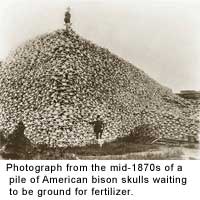 Make Way For The Railroads: Bison were hunted almost to extinction in the 19th century and were reduced to a few hundred head by the mid-1880s, from which all the present day's managed herds are descended. One major cause was that hunters were paid by large railroad concerns to destroy entire herds, for several reasons: Make Way For The Railroads: Bison were hunted almost to extinction in the 19th century and were reduced to a few hundred head by the mid-1880s, from which all the present day's managed herds are descended. One major cause was that hunters were paid by large railroad concerns to destroy entire herds, for several reasons:
* The herds formed the basis of the economies of local Plains tribes of Native Americans; without bison, the tribes would leave.
* Herds of these large animals on tracks could damage locomotives when the trains failed to stop in time.
* Herds often took shelter in the artificial cuts formed by the grade of the track winding though hills and mountains in harsh winter conditions. As a result, the herds could delay a train for days.
 Bison Skins: Bison skins were used for industrial machine belts, clothing such as robes, and rugs. There was a huge export trade to Europe of bison hides. Old West bison hunting was very often a big commercial enterprise, involving organized teams of one or two professional hunters, backed by a team of skinners, gun cleaners, cartridge reloaders, cooks, wranglers, blacksmiths, security guards, teamsters, and numerous horses and wagons. Men were even employed to recover and re-cast lead bullets taken from the carcasses. Bison Skins: Bison skins were used for industrial machine belts, clothing such as robes, and rugs. There was a huge export trade to Europe of bison hides. Old West bison hunting was very often a big commercial enterprise, involving organized teams of one or two professional hunters, backed by a team of skinners, gun cleaners, cartridge reloaders, cooks, wranglers, blacksmiths, security guards, teamsters, and numerous horses and wagons. Men were even employed to recover and re-cast lead bullets taken from the carcasses.
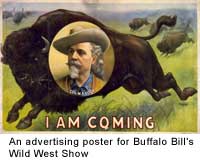 Professional Hunters: Many of these professional hunters such as Buffalo Bill Cody killed over a hundred animals at a single stand and many thousands in their career. One professional hunter killed over 20,000 by his own count. A good hide could bring $3.00 in Dodge City, and a very good one (the heavy winter coat) could sell for $50.00 in an era when a laborer would be lucky to make a dollar a day. Professional Hunters: Many of these professional hunters such as Buffalo Bill Cody killed over a hundred animals at a single stand and many thousands in their career. One professional hunter killed over 20,000 by his own count. A good hide could bring $3.00 in Dodge City, and a very good one (the heavy winter coat) could sell for $50.00 in an era when a laborer would be lucky to make a dollar a day.
How To Hunt: The hunter would customarily locate the herd in the early morning, and station himself about 100 meters from it, shooting the animals broadside through the lungs. Head shots were not preferred as the soft lead bullets would often flatten and fail to penetrate the skull, especially if mud was matted on the head of the animal. The bison would drop until either the herd sensed danger and stampeded or perhaps a wounded animal attacked another, causing the herd to disperse. If done properly a large number of bison would be felled at one time. Following up were the skinners, who would drive a spike through the nose of each dead animal with a sledgehammer, hook up a horse team, and pull the hide from the carcass. The hides were dressed, prepared, and stacked on the wagons by other members of the organization.
Commercial Hide Hunting Outfits: For a decade from 1873 on there were several hundred, perhaps over a thousand, such commercial hide hunting outfits harvesting bison at any one time, vastly exceeding the take by American Indians or individual meat hunters. The commercial take arguably was anywhere from 2000 to 100,000 animals per day depending on the season, though there are no statistics available. It was said that the Big .50s were fired so much that hunters needed at least two rifles to let the barrels cool off, and they were sometimes quenched in the winter snow. Dodge City saw railroad cars sent East filled with stacked hides.
Protection Proposals: As the great herds began to wane, proposals to protect the bison were discussed. Cody, among others, spoke in favor of protecting the bison because he saw that the pressure on the species was too great. But these were discouraged since it was recognized that the Plains Indians, often at war with the United States, depended on bison for their way of life. General Phillip Sheridan spoke to the Texas Legislature against a proposal to outlaw commercial bison hunting for that reason, and President Grant also "pocket vetoed" a similar Federal bill to protect the dwindling bison herds. By 1884, the American Bison was close to extinction.
The destruction of the bison was resisted by many of the Plains Indians but not with success. The Indians did not participate in commercial hunting of the bison.
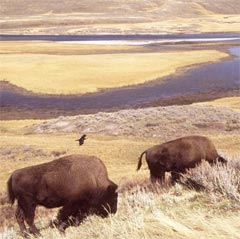 Only 750 Left: As few as 750 bison existed in 1890. The Famous Buffalo Herd of James "Scotty" Philip in South Dakota was the beginning of the reintroduction of Bison to North America. In 1899, he purchased a small herd from Dug Carlin, Pete Dupree's brother-in-law, whose son Fred had roped 5 calves in the Last Big Buffalo Hunt on the Grand River in 1881 and taken them back home to the ranch on the Cheyenne River. Only 750 Left: As few as 750 bison existed in 1890. The Famous Buffalo Herd of James "Scotty" Philip in South Dakota was the beginning of the reintroduction of Bison to North America. In 1899, he purchased a small herd from Dug Carlin, Pete Dupree's brother-in-law, whose son Fred had roped 5 calves in the Last Big Buffalo Hunt on the Grand River in 1881 and taken them back home to the ranch on the Cheyenne River.
At the Time of Purchase there where approximately 74 Pure buffalo and it was believed to be one of the largest known herds left in North America. Scotty's goal was to preserve the animal from extinction. At the time of his death in 1911 at 53, Scotty had grown the herd to an estimated 1,000 to 1,200 head of Bison.
Success Story: A variety of privately-owned herds have also been established, starting from this population. The current American Bison population has been growing rapidly and is estimated at 350,000, but this is compared to an estimated 60–100 million in the mid-19th century. Current herds, however, are all partly crossbred with cattle (see "beefalo"); today there are only four genetically unmixed herds and only one that is also free of brucellosis: it roams Wind Cave National Park. A founder population from the Wind Cave herd was recently established in Montana by the World Wildlife Fund.
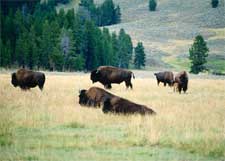 Yellowstone National Park: The only continuously wild bison herd in the United States resides within Yellowstone National Park. Numbering between 3000 and 3500, this herd is descended from a remnant population of 23 individual mountain bison that survived the mass slaughter of the 1800's by hiding out in the Pelican Valley of Yellowstone Park. In 1902, a captive herd of 21 plains bison were introduced to the Lamar Valley and managed as livestock until the 1960s, when a policy of natural regulation was adopted by the park. Yellowstone National Park: The only continuously wild bison herd in the United States resides within Yellowstone National Park. Numbering between 3000 and 3500, this herd is descended from a remnant population of 23 individual mountain bison that survived the mass slaughter of the 1800's by hiding out in the Pelican Valley of Yellowstone Park. In 1902, a captive herd of 21 plains bison were introduced to the Lamar Valley and managed as livestock until the 1960s, when a policy of natural regulation was adopted by the park.
Migration At Yellowstone: The end of the ranching era and the onset of the natural regulation era set into motion a chain of events that have led to the bison of Yellowstone Park migrating to lower elevations outside the park in search of winter forage. The presence of wild bison in Montana is perceived as a threat to many cattle ranchers, who fear that the small percentage of bison that carry brucellosis will infect livestock and cause cows to abort their first calves. However, there has never been a documented case of brucellosis being transmitted to cattle from wild bison. The management controversy that began in the early 1980s continues to this day, with advocacy groups arguing that the Yellowstone herd should be protected as a distinct population segment under the Endangered Species Act.
Bison Hunting Today: Hunting of wild bison is legal in some states and provinces where public herds require culling to maintain a target population. In Alberta, where one of only two continuously wild herds of bison exist in North America at Wood Buffalo National Park, bison are hunted to protect disease free herds of public (reintroduced) and private herds of bison. In Montana a public hunt was re-established in 2005, with 50 permits being issued. The Montana Fish, Wildlife and Parks Commission increased the number of tags to 140 for the 2006/2007 season. Advocacy groups claim that it is premature to re-establish the hunt, given the bison's lack of habitat and wildlife status in Montana.
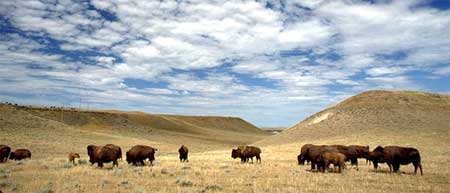
Bison Burgers! Bison are now raised for meat and hides. Over 250,000 of the 350,000 remaining bison are being raised for human consumption. Bison meat is lower in fat and cholesterol than beef which has led to the development of beefalo, a fertile cross-breed of bison and domestic cattle. In 2005, about 35,000 bison were processed for meat in the U.S., with the National Bison Association and USDA providing a "Certified American Buffalo" program with birth-to-consumer tracking of bison via RFID ear tags.
Genetic Studies: Recent genetic studies of privately-owned herds of bison show that many of them include animals with genes from domestic cattle; there are as few as 12,000 to 15,000 pure bison in the world. The numbers are uncertain because the tests so far used mitochondrial DNA analysis, and thus would miss cattle genes inherited in the male line; most of the hybrids look exactly like purebred bison.
Nickel: The American Bison was depicted on the reverse side of the U.S. "buffalo nickel" from 1913 to 1938. In 2005, the United States Mint coined a nickel with a new depiction of the bison as part of its "Westward Journey" series; the Kansas quarter has a depiction of the bison on its reverse as part of its "50 State Quarter" series. The Kansas State Quarter only has the bison and does not feature any writing.
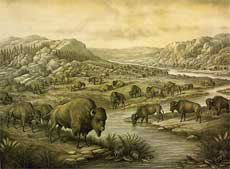 Symbols: The bison is a symbol of Manitoba, the Royal Canadian Mounted Police, Bucknell University, the University of Colorado, Lipscomb University, Marshall University, the Independence Party of Minnesota, and North Dakota State University. It is also commonly used as a symbol of the city of Buffalo, New York, although the city was not named for the animal. The bison is also the state mammal of Wyoming. Symbols: The bison is a symbol of Manitoba, the Royal Canadian Mounted Police, Bucknell University, the University of Colorado, Lipscomb University, Marshall University, the Independence Party of Minnesota, and North Dakota State University. It is also commonly used as a symbol of the city of Buffalo, New York, although the city was not named for the animal. The bison is also the state mammal of Wyoming.
Custer State Park in South Dakota is home to 1,500 bison, one of the largest publicly-held herds in the world.
Buffalo Commons: A proposal known as Buffalo Commons has been suggested by a handful of academics and policymakers to restore large parts of the drier portion of the Great Plains to native prairie grazed by bison. Proponents argue that current agricultural use of the shortgrass prairie is not sustainable, pointing to periodic disasters such as the Dust Bowl and continuing significant population loss over the last 60 years. However, this plan is opposed by most who live in the sparsely-populated area, though it might benefit participating states economically.
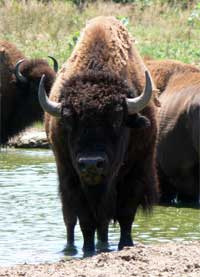 Dangerous! Bison are among the most dangerous animals encountered by visitors to the various National Parks, especially Yellowstone National Park. Although they are not carnivorous, they will attack humans if provoked. They appear slow because of their lethargic movements, but they can easily outrun humans—they have been observed running as fast as 45 miles per hour (73 km/h). Between 1978 and 1992, over Dangerous! Bison are among the most dangerous animals encountered by visitors to the various National Parks, especially Yellowstone National Park. Although they are not carnivorous, they will attack humans if provoked. They appear slow because of their lethargic movements, but they can easily outrun humans—they have been observed running as fast as 45 miles per hour (73 km/h). Between 1978 and 1992, over
four times as many people in Yellowstone National Park were killed or injured
by bison as by bears (12 by bears, 56
by bison). Bison also have the
unexpected ability, given the animal's size and body structure, to jump straight up in the air, and they can leap over a
standard barbed-wire fence.
European Bison: The Wisent or European bison (Bison bonasus) is a bison species and the heaviest land animal in Europe. A typical wisent is about 2.9 m long and 1.8–1.9 m tall, and weighs 300 to 920 kg. It is shorter and less massive than the related American bison (B. bison), and has shorter hair on the neck, head, and forequarters. Wisents are forest-dwelling. They have few predators with only scattered reports from the 1800s of wolf and bear predation. Wisents were first scientifically described by Carolus Linnaeus in 1758. Some later descriptions treat the wisent as conspecific with the American bison. It is not to be confused with the aurochs.
Endangered: The species is now endangered. In the past they were commonly killed to produce hides and drinking horns especially in the middle ages.

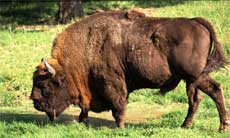 Wisent have lived as long as 28 years in captivity although in the wild their lifespan is shorter. Productive breeding years are between 4 and 20 years old in females and only between 6 and 12 years old in males. Wisent occupy home ranges of as much as 100 square kilometers and some herds are found to prefer meadows and open areas in forests. Wisent have lived as long as 28 years in captivity although in the wild their lifespan is shorter. Productive breeding years are between 4 and 20 years old in females and only between 6 and 12 years old in males. Wisent occupy home ranges of as much as 100 square kilometers and some herds are found to prefer meadows and open areas in forests.
Wisent can cross-breed with American bison. The products of a German interbreeding program were destroyed after World War II. This program was related to the impulse which created the Heck cattle. The cross-bred individuals created at other zoos were eliminated from breed books by the 1950s. A Russian back-breeding program resulted in a wild herd of hybrid animals which presently lives in the Caucasian Biosphere Reserve (550 individuals in 1999).
There are also bison-wisent-cattle hybrids. In 1847 a herd of wisent-cattle hybrids named żubroń was created by Leopold Walicki. The animal was to become a durable and cheap alternative to cattle. The experiment was continued by researchers from the Polish Academy of Sciences until the late 1980s. Although the program resulted in a quite successful animal that was both hardy and could be bred in marginal grazing lands, it was eventually discontinued. Currently the only surviving żubroń herd consists of just a few animals in Bialowieza Forest, Poland.

Their mating habits are polygamous: dominant bulls maintain a small harem of females for mating. Individual bulls "tend" females until allowed to mate, following them around and chasing away rival males.
|